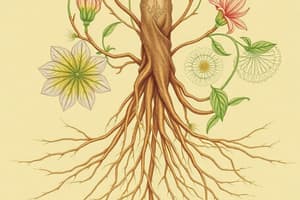Podcast
Questions and Answers
What does plant anatomy study?
What does plant anatomy study?
- Plant interactions with their environment
- Functions and processes of plants
- Internal structure of plants (correct)
- Classification and naming of plants
Which process do plants use to convert light energy into chemical energy?
Which process do plants use to convert light energy into chemical energy?
- Photosynthesis (correct)
- Transpiration
- Respiration
- Fermentation
Which of the following is NOT a major plant group?
Which of the following is NOT a major plant group?
- Bryophytes
- Spermatophytes (correct)
- Gymnosperms
- Angiosperms
What term describes the study of plant interactions with humans?
What term describes the study of plant interactions with humans?
Which organelles are primarily involved in photosynthesis?
Which organelles are primarily involved in photosynthesis?
What type of reproduction involves the use of seeds and flowers?
What type of reproduction involves the use of seeds and flowers?
Which branch of botany focuses on the classification and naming of plants?
Which branch of botany focuses on the classification and naming of plants?
Which of the following is a method used in botanical research?
Which of the following is a method used in botanical research?
Flashcards are hidden until you start studying
Study Notes
Overview of Botany
- Definition: Botany is the scientific study of plants, including their physiology, structure, genetics, ecology, distribution, classification, and economic importance.
Branches of Botany
- Plant Anatomy: Study of the internal structure of plants.
- Plant Physiology: Examines the functions and processes of plants.
- Plant Ecology: Focuses on plant interactions with their environment.
- Plant Taxonomy: Classification and naming of plants.
- Plant Genetics: Study of heredity and variation in plants.
- Ethnobotany: Explores the relationship between plants and people.
Key Concepts
- Photosynthesis: Process by which plants convert light energy into chemical energy (glucose) using chlorophyll.
- Plant Cell Structure:
- Cell Wall: Rigid outer layer providing structure.
- Chloroplasts: Organelles where photosynthesis occurs.
- Vacuoles: Storage for nutrients and waste products.
- Plant Reproduction:
- Asexual Reproduction: Involves vegetative propagation (e.g., runners, tubers).
- Sexual Reproduction: Involves flowers, seeds, and fertilization.
Plant Classification
- Major Plant Groups:
- Bryophytes: Non-vascular plants (e.g., mosses).
- Pteridophytes: Vascular, spore-producing plants (e.g., ferns).
- Gymnosperms: Seed-producing plants with exposed seeds (e.g., conifers).
- Angiosperms: Flowering plants that produce seeds enclosed in fruits.
Importance of Botany
- Ecological Role: Plants produce oxygen and serve as the base of food chains.
- Economic Importance: Source of food, medicine, and raw materials.
- Conservation: Studies plant diversity and the impact of human activities on ecosystems.
Techniques in Botany
- Field Studies: Observing and collecting plant samples in natural habitats.
- Laboratory Research: Analyzing plant anatomy, physiology, and genetics.
- Molecular Techniques: DNA sequencing and genetic modification studies.
Current Trends in Botany
- Climate Change Impact: Research on how climate affects plant distribution and health.
- Biotechnology: Genetic engineering for improved crop yields and resistance.
- Conservation Biology: Efforts to protect endangered plant species and habitats.
Overview of Botany
- Botany is the scientific discipline focused on the study of plants.
- Areas of study encompass physiology, structure, genetics, ecology, distribution, classification, and economic relevance.
Branches of Botany
- Plant Anatomy: Involves the analysis of the internal structure of plants.
- Plant Physiology: Investigates the various functions and processes that sustain plant life.
- Plant Ecology: Examines how plants interact with their environment, including biotic and abiotic factors.
- Plant Taxonomy: Concerned with the classification and systematic naming of plant species.
- Plant Genetics: Studies heredity, variation, and genetic diversity among plant species.
- Ethnobotany: Explores the cultural and practical relationships between plants and human societies.
Key Concepts
- Photosynthesis is the process where plants convert light energy into glucose using chlorophyll, essential for plant growth and energy.
- Plant Cell Structure:
- Cell Wall: Provides rigidity and support to plant cells.
- Chloroplasts: Contain chlorophyll and are the sites of photosynthesis.
- Vacuoles: Serve as storage compartments for nutrients and waste products.
- Plant Reproduction:
- Asexual Reproduction involves methods like vegetative propagation through runners or tubers.
- Sexual Reproduction occurs via flowers, seed formation, and fertilization.
Plant Classification
- Major Plant Groups:
- Bryophytes: Non-vascular plants like mosses that typically thrive in moist environments.
- Pteridophytes: Vascular plants that reproduce through spores, including ferns.
- Gymnosperms: Seed-producing plants with naked seeds, commonly represented by conifers.
- Angiosperms: Flowering plants that produce seeds encased in fruits, often the most diverse group.
Importance of Botany
- Ecological Role: Plants play a critical role in oxygen production and form the fundamental basis of food chains.
- Economic Importance: Plants are vital sources of food, medicines, and raw materials for various industries.
- Conservation: Research in botany assists in understanding plant diversity and mitigating human impact on ecosystems.
Techniques in Botany
- Field Studies: Involve the observation and collection of plant specimens in their natural settings.
- Laboratory Research: Focuses on detailed studies of plant anatomy, physiology, and genetic makeup.
- Molecular Techniques: Utilize methods such as DNA sequencing and genetic modification to analyze and improve plant traits.
Current Trends in Botany
- Climate Change Impact: Ongoing studies evaluate how shifts in climate influence plant health and distribution patterns.
- Biotechnology: Genetic engineering is being explored to enhance crop resilience and yield efficiency.
- Conservation Biology: Initiatives aim to protect endangered plant species and restore their natural habitats.
Studying That Suits You
Use AI to generate personalized quizzes and flashcards to suit your learning preferences.




